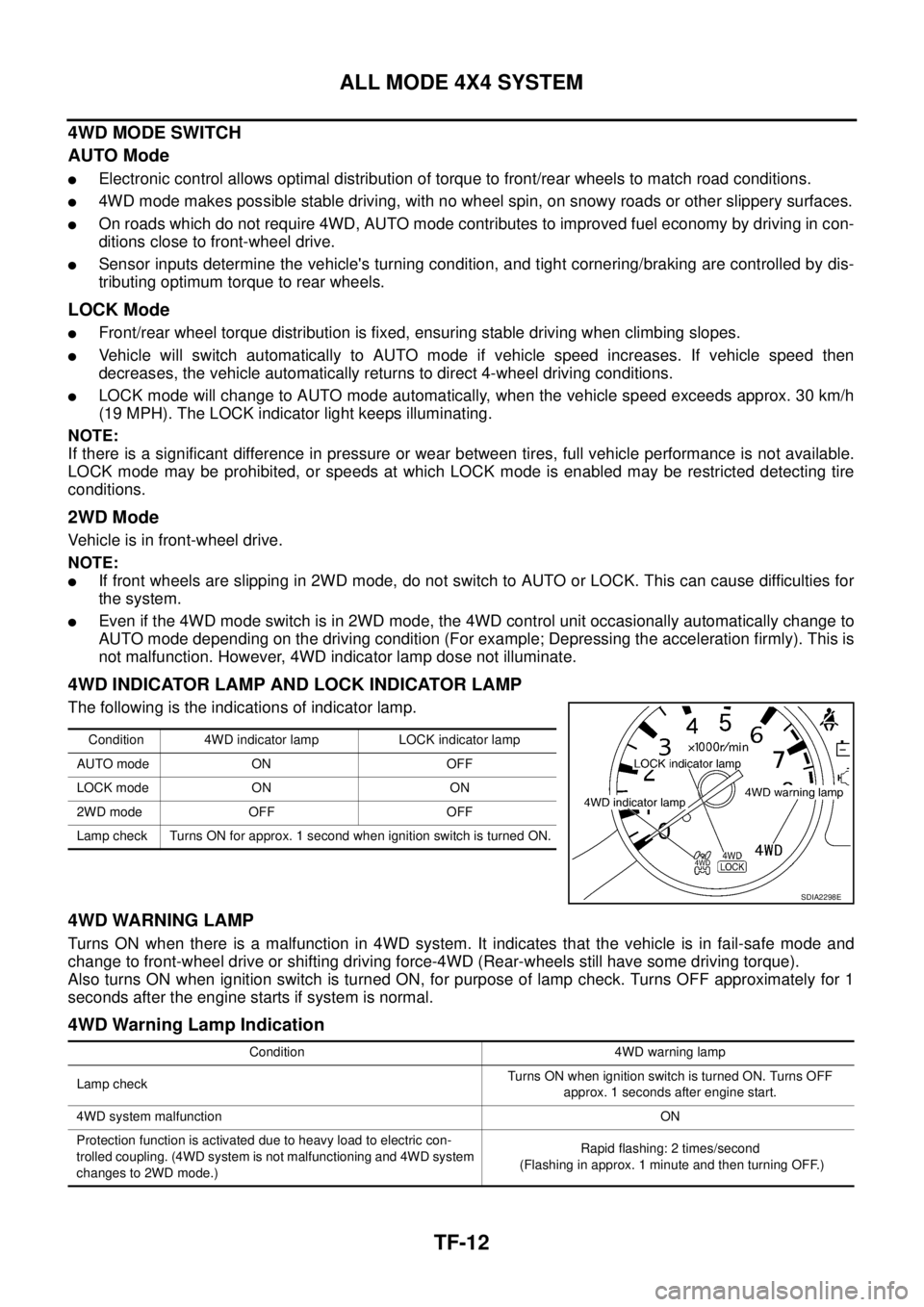Page 2716 of 4555
![NISSAN X-TRAIL 2005 Service Repair Manual AT-452
[ALL]
REPAIR FOR COMPONENT PARTS
�Check to see that retainer plates are properly positioned in con-
trol valve upper body.
Oil Strainer
�Check wire netting of oil strainer for damage.
Shift S NISSAN X-TRAIL 2005 Service Repair Manual AT-452
[ALL]
REPAIR FOR COMPONENT PARTS
�Check to see that retainer plates are properly positioned in con-
trol valve upper body.
Oil Strainer
�Check wire netting of oil strainer for damage.
Shift S](/manual-img/5/57403/w960_57403-2715.png)
AT-452
[ALL]
REPAIR FOR COMPONENT PARTS
�Check to see that retainer plates are properly positioned in con-
trol valve upper body.
Oil Strainer
�Check wire netting of oil strainer for damage.
Shift Solenoid Valves “A” and “B”, Line Pressure Solenoid Valve, Torque Converter Clutch
Solenoid Valve and Overrun Clutch Solenoid Valve
�Measure resistance.
�Except for EURO-OBD:
�For shift solenoid valve A, refer to AT- 3 5 0 , "SHIFT SOLENOID
VALVE A" .
�For shift solenoid valve B, refer to AT- 3 5 6 , "SHIFT SOLENOID
VALVE B" .
�For line pressure solenoid valve, refer to AT- 3 8 7 , "LINE PRES-
SURE SOLENOID VALVE" .
�For torque converter clutch solenoid valve, refer to AT- 3 6 8 ,
"TORQUE CONVERTER CLUTCH SOLENOID VALVE" .
�For overrun clutch solenoid valve, refer to AT- 3 6 2 , "OVERRUN
CLUTCH SOLENOID VALVE" .
�For A/T fluid temperature sensor, refer toAT-374, "BATT/FLUID TEMP SEN (A/T FLUID TEMP SENSOR
CIRCUIT AND TCM POWER SOURCE)" .
�EURO-OBD:
�For shift solenoid valve A, refer to AT- 1 6 1 , "DTC P0750 SHIFT SOLENOID VALVE A" .
�For shift solenoid valve B, refer to AT- 1 6 7 , "DTC P0755 SHIFT SOLENOID VALVE B" .
�For line pressure solenoid valve, refer to AT- 1 5 4 , "DTC P0745 LINE PRESSURE SOLENOID VALVE" .
�For torque converter clutch solenoid valve, refer to AT- 1 4 8 , "DTC P0740 TORQUE CONVERTER
CLUTCH SOLENOID VALVE" .
�For overrun clutch solenoid valve, refer to AT- 1 7 8 , "DTC P1760 OVERRUN CLUTCH SOLENOID VALVE"
.
�For A/T fluid temperature sensor, refer to AT- 1 8 4 , "DTC BATT/FLUID TEMP SEN (A/T FLUID TEMP SEN-
SOR CIRCUIT AND TCM POWER SOURCE)" .
SCIA4979E
SCIA3291E
SCIA0805E
Page 2792 of 4555
![NISSAN X-TRAIL 2005 Service Repair Manual AT-528
[ALL]
ASSEMBLY
g. Tighten control valve assembly fixing bolts A , B and C to the specified torque. Refer to AT- 4 1 6 , "Compo-
nents" .
Bolt length, number and location:
CAUTION:
�Do not NISSAN X-TRAIL 2005 Service Repair Manual AT-528
[ALL]
ASSEMBLY
g. Tighten control valve assembly fixing bolts A , B and C to the specified torque. Refer to AT- 4 1 6 , "Compo-
nents" .
Bolt length, number and location:
CAUTION:
�Do not](/manual-img/5/57403/w960_57403-2791.png)
AT-528
[ALL]
ASSEMBLY
g. Tighten control valve assembly fixing bolts A , B and C to the specified torque. Refer to AT- 4 1 6 , "Compo-
nents" .
Bolt length, number and location:
CAUTION:
�Do not reuse idler gear bearing.
�Apply ATF to idler gear bearing.
18. Install PNP switch.
a. Set manual shaft in “P” position.
b. Temporarily install PNP switch on manual shaft.
c. Move manual shaft to “N” position.
d. Use a 3 mm (0.12 in) pin for this adjustment.
i. Insert the pin straight into the manual shaft adjustment hole.
ii. Rotate PNP switch until the pin can also be inserted straight into
hole in PNP switch.
e. Tighten PNP switch fitting bolts. Refer to AT- 4 1 6 , "
Components"
.
f. Remove pin from adjustment hole after adjusting PNP switch.
19. Install bracket on transaxle case.
20. Install O-ring on revolution sensor.
CAUTION:
�Do not reuse O-ring.
�Apply petroleum jelly to O-ring.
21. Install revolution sensor on transaxle case.
Bolt symbol A B C
Bolt length “ ” mm (in)
40.0 mm
(1.575 in)33.0 mm
(1.299 in)43.5 mm
(1.713 in)
Number of bolts 5 6 2
AAT260A
SCIA3154E
SCIA4930E
Page 2804 of 4555
AT-540
[ALL]
SERVICE DATA AND SPECIFICATIONS (SDS)
A/T Fluid Temperature SensorECS00F29
Remarks: Specification data are reference values.
Revolution SensorECS00F2A
Dropping ResistorECS00F2B
Monitor item Condition Specification (Approximately)
A/T fluid temperature sensorCold [20°C (68°F)]
↓
Hot [80°C (176°F)]1.5V
↓
0.5V2.5 kΩ
↓
0.3 kΩ
Condition Judgement standard
When moving at 20 km/h (12 MPH), use the CONSULT-II pulse frequency measuring func-
tion.450 Hz (Approx.)
When vehicle parks.Under 1.3V or over 4.5V
Resistance12Ω (Approx)
Page 2815 of 4555
ALL MODE 4X4 SYSTEM
TF-11
C
E
F
G
H
I
J
K
L
MA
B
TF
ALL MODE 4X4 SYSTEMPFP:47850
Power Transfer DiagramEDS001VA
System DescriptionEDS001VB
ELECTRIC CONTROLLED COUPLING
Operation Principle
1. The 4WD control unit supplies command current to electric con-
trolled coupling (4WD solenoid).
2. The control clutch is engaged by electromagnet and torque is
detected in control clutch.
3. The cam operates in response to control clutch torque and
applies pressure to main clutch.
4. The main clutch transmits torque to front wheels according to
pressing power.
�Transmission torque to the rear wheels is determined accord-
ing to command current.
4WD CONTROL UNIT
�4WD controls distribution of drive power between front-wheel
drive (100:0) and 4WD (50:50) conditions according to signals
from sensors.
�Self-diagnosis can be done with CONSULT-II.
SDIA1607E
SFIA0284E
SDIA1844E
SDIA2285E
Page 2816 of 4555

TF-12
ALL MODE 4X4 SYSTEM
4WD MODE SWITCH
AUTO Mode
�Electronic control allows optimal distribution of torque to front/rear wheels to match road conditions.
�4WD mode makes possible stable driving, with no wheel spin, on snowy roads or other slippery surfaces.
�On roads which do not require 4WD, AUTO mode contributes to improved fuel economy by driving in con-
ditions close to front-wheel drive.
�Sensor inputs determine the vehicle's turning condition, and tight cornering/braking are controlled by dis-
tributing optimum torque to rear wheels.
LOCK Mode
�Front/rear wheel torque distribution is fixed, ensuring stable driving when climbing slopes.
�Vehicle will switch automatically to AUTO mode if vehicle speed increases. If vehicle speed then
decreases, the vehicle automatically returns to direct 4-wheel driving conditions.
�LOCK mode will change to AUTO mode automatically, when the vehicle speed exceeds approx. 30 km/h
(19 MPH). The LOCK indicator light keeps illuminating.
NOTE:
If there is a significant difference in pressure or wear between tires, full vehicle performance is not available.
LOCK mode may be prohibited, or speeds at which LOCK mode is enabled may be restricted detecting tire
conditions.
2WD Mode
Vehicle is in front-wheel drive.
NOTE:
�If front wheels are slipping in 2WD mode, do not switch to AUTO or LOCK. This can cause difficulties for
the system.
�Even if the 4WD mode switch is in 2WD mode, the 4WD control unit occasionally automatically change to
AUTO mode depending on the driving condition (For example; Depressing the acceleration firmly). This is
not malfunction. However, 4WD indicator lamp dose not illuminate.
4WD INDICATOR LAMP AND LOCK INDICATOR LAMP
The following is the indications of indicator lamp.
4WD WARNING LAMP
Turns ON when there is a malfunction in 4WD system. It indicates that the vehicle is in fail-safe mode and
change to front-wheel drive or shifting driving force-4WD (Rear-wheels still have some driving torque).
Also turns ON when ignition switch is turned ON, for purpose of lamp check. Turns OFF approximately for 1
seconds after the engine starts if system is normal.
4WD Warning Lamp Indication
Condition 4WD indicator lamp LOCK indicator lamp
AUTO mode ON OFF
LOCK mode ON ON
2WD mode OFF OFF
Lamp check Turns ON for approx. 1 second when ignition switch is turned ON.
SDIA2298E
Condition 4WD warning lamp
Lamp checkTurns ON when ignition switch is turned ON. Turns OFF
approx. 1 seconds after engine start.
4WD system malfunctionON
Protection function is activated due to heavy load to electric con-
trolled coupling. (4WD system is not malfunctioning and 4WD system
changes to 2WD mode.)Rapid flashing: 2 times/second
(Flashing in approx. 1 minute and then turning OFF.)
Page 2818 of 4555

TF-14
ALL MODE 4X4 SYSTEM
COMPONENTS FUNCTION DESCRIPTION
CAN CommunicationEDS0027K
SYSTEM DESCRIPTION
CAN (Controller Area Network) is a serial communication line for real time application. It is an on-vehicle mul-
tiplex communication line with high data communication speed and excellent error detection ability. Many elec-
tronic control units are equipped onto a vehicle, and each control unit shares information and links with other
control units during operation (not independent). In CAN communication, control units are connected with 2
communication lines (CAN H line, CAN L line) allowing a high rate of information transmission with less wiring.
Each control unit transmits/receives data but selectively reads required data only.
CAN Communication UnitEDS002XA
Component parts Function
4WD control unit
�Controls driving force distribution by signals from each sensor and switch from front wheel driving
mode (100:0) to 4WD mode (50:50).
�2WD mode is available by fail-safe function if malfunction is detected in electrical system.
Wheel sensors Detects wheel speed.
4WD solenoid Controls electric controlled coupling by operation signal from 4WD control unit.
Electric controlled coupling Transmits driving force to rear final drive.
4WD mode switch Able to select from 2WD, AUTO or LOCK mode.
4WD warning lamp
�Illuminates if malfunction is detected in electrical system of 4WD system.
�There is 1 blink in 2 seconds if rotation difference of front wheels and rear wheels is large.
�There are 2 blinks in 1 second if load is still applied to driving parts.
4WD indicator lamp Indicate operation with optimal distribution of torque to front/rear wheels.
LOCK indicator lamp Indicate that 4WD system is under direct 4-wheel driving mode.
ABS actuator and electric unit
(control unit) (without ESP) or
ESP/TCS/ABS control unit (with
ESP)Transmits the following signals via CAN communication to 4WD control unit.
�Vehicle speed signal
�Stop lamp switch signal (brake signal)
ECMTransmits the following signals via CAN communication to 4WD control unit.
�Accelerator pedal position signal
�Engine speed signal
Unified meter control unit Transmits conditions of parking brake switch via CAN communication to 4WD control unit.
Body typeWagon
Axle4WD
Engine YD22DDTi QR20DE/QR25DE YD22DDTi QR25DE
Transmission M/T A/T M/T A/T
Brake control ABS ESP
CAN system type 123456
Page 2821 of 4555
ALL MODE 4X4 SYSTEM
TF-17
C
E
F
G
H
I
J
K
L
MA
B
TF
TYPE 4/TYPE 5
System diagram
Input/output signal chart
T: Transmit R: Receive ASCD SET lamp signal TR
ASCD CRUISE lamp signal TR Signals ECM TCMABS actuator
and electric unit
(control unit)4WD control
unitCombination
meter
PKIA9634E
Signals ECMESP/TCS/ABS
control unitSteering angle
sensor4WD control
unitCombination
meter
4WD mode indicator lamp signalTR
4WD warning lamp signalTR
A/C compressor feedback signal*
2TR
A/C switch signal*
1RT
ABS warning lamp signal T R
Accelerator pedal position signal T R R
Brake warning lamp signal T R
Engine coolant temperature signal TR
Engine speed signal T R R R
ESP OFF indicator lamp signal T R
Glow indicator lamp signal*1 TR
MI signal TR
Stop lamp switch signal T R
Vehicle speed signalTRR
RT
SLIP indicator lamp signal T R
Parking brake switch signalRT
Steering angle sensor signal R T
ASCD SET lamp signal TR
ASCD CRUISE lamp signal TR
Page 2822 of 4555
TF-18
ALL MODE 4X4 SYSTEM
*1: YD engine models only
*2: QR engine models only
TYPE 6
System diagram
Input/output signal chart
T: Transmit R: Receive
PKIA9635E
Signals ECM TCMESP/TCS/
ABS control
unitSteering
angle sensor4WD control
unitCombination
meter
4WD mode indicator lamp signalTR
4WD warning lamp signalTR
A/C compressor feedback signal TR
A/T position indicator lamp signal T R R
A/T self-diagnosis signal R T
ABS warning lamp signal T R
Accelerator pedal position signal T R R
Brake warning lamp signal T R
Closed throttle position signal T R
Engine and A/T integratedTR
RT
Engine coolant temperature signal TR
Engine speed signal T R R R
ESP OFF indicator lamp signal T R
MI signal TR
O/D OFF indicator signal T R
Output shaft revolution signal R T
Overdrive control switch signal R T
P·N range signal R T
SLIP indicator lamp signal T R
Steering angle sensor signal R T